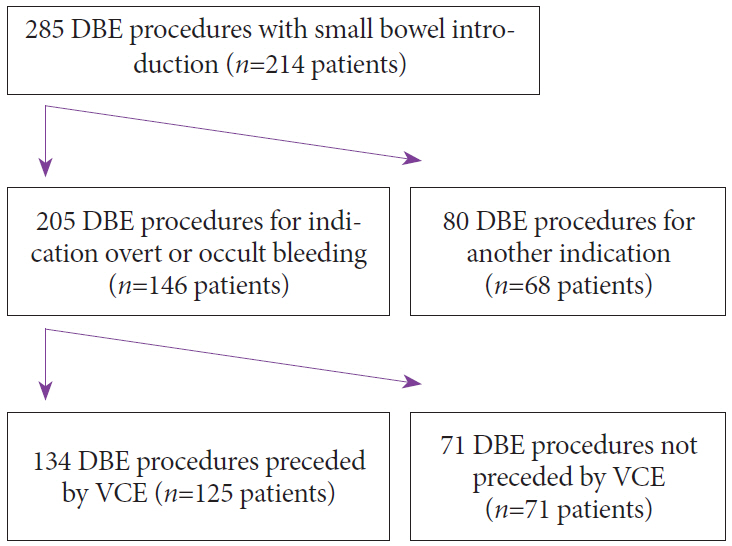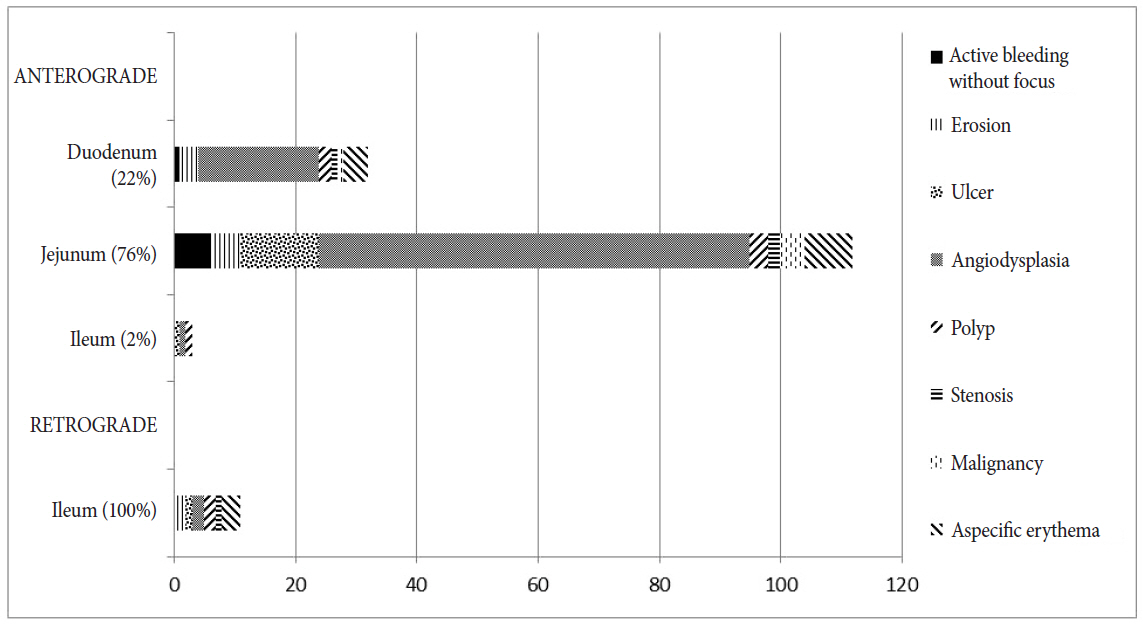Clin Endosc.
2017 Jan;50(1):69-75. 10.5946/ce.2016.079.
Double-Balloon Endoscopy in Overt and Occult Small Bowel Bleeding: Results, Complications, and Correlation with Prior Videocapsule Endoscopy in a Tertiary Referral Center
- Affiliations
-
- 1Department of Gastroenterology and Hepatology, Catharina Ziekenhuis, Eindhoven, Netherlands. Cjmhermans@gmail.com
- 2Department of Gastroenterology and Hepatology, Elkerliek Ziekenhuis, Helmond, Netherlands.
- 3Department of Gastroenterology and Hepatology, Máxima Medisch Centrum, Veldhoven, Netherlands.
- 4Department of Gastroenterology and Hepatology, Bernhoven Ziekenhuis, Uden, Netherlands.
- 5Department of Gastroenterology and Hepatology, Sint Jans Gasthuis, Weert, Netherlands.
- KMID: 2383493
- DOI: http://doi.org/10.5946/ce.2016.079
Abstract
- BACKGROUND/AIMS
Videocapsule endoscopy (VCE) and double-balloon endoscopy (DBE) allow deep exploration in patients with suspected small bowel pathology. VCE is often performed as an initial small bowel examination to explore whether an intervention by DBE is indicated and to determine insertion route. The study aim was to evaluate the correlation between DBE and VCE in patients with obscure or overt bleeding or anemia, as well as intervention frequency, and complications.
METHODS
Retrospective observational study.
RESULTS
DBE procedures (n=205) showed small bowel lesions in 64% cases. Antegrade DBE showed positive results in 79% cases, mostly angiodysplasias (63%). Retrograde DBE showed positive results in 22% cases. An intervention was performed in 64% of DBE procedures. The major complication rate was 0.5%, which was one case of perforation. Pancreatitis did not occur. The overall diagnostic agreement was 66% among the 134 DBEs with preceded VCE.
CONCLUSIONS
In cases of overt or occult bleeding or anemia, DBE was positive in 64%, with only a few complications. Positive correlation was 66% among initially performed VCEs and DBEs. Owing to the time-consuming and invasive character of DBE, performing VCE before DBE might still be clinically relevant.
MeSH Terms
Figure
Cited by 2 articles
-
Clinicopathological Features of Small Bowel Tumors Diagnosed by Video Capsule Endoscopy and Balloon-Assisted Enteroscopy: A Single Center Experience
Ah Young Yoo, Beom Jae Lee, Won Shik Kim, Seong Min Kim, Seung Han Kim, Moon Kyung Joo, Hyo Jung Kim, Jong-Jae Park
Clin Endosc. 2021;54(1):85-91. doi: 10.5946/ce.2020.047.What is the Role of Double-Balloon Endoscopy in Patients Presenting with Obscure Gastrointestinal Bleeding?
Jung Ho Kim, Kwang An Kwon
Clin Endosc. 2017;50(1):8-10. doi: 10.5946/ce.2017.023.
Reference
-
1. Aktas H, Mensink PB. Small bowel diagnostics: current place of small bowel endoscopy. Best Pract Res Clin Gastroenterol. 2012; 26:209–220.
Article2. Xin L, Liao Z, Jiang YP, Li ZS. Indications, detectability, positive findings, total enteroscopy, and complications of diagnostic double-balloon endoscopy: a systematic review of data over the first decade of use. Gastrointest Endosc. 2011; 74:563–570.
Article3. Möschler O, May A, Müller MK, Ell C. Complications in and performance of double-balloon enteroscopy (DBE): results from a large prospective DBE database in Germany. Endoscopy. 2011; 43:484–489.
Article4. Kondo J, Iijima H, Abe T, et al. Roles of double-balloon endoscopy in the diagnosis and treatment of Crohn’s disease: a multicenter experience. J Gastroenterol. 2010; 45:713–720.
Article5. Teshima CW, Kuipers EJ, van Zanten SV, Mensink PB. Double balloon enteroscopy and capsule endoscopy for obscure gastrointestinal bleeding: an updated meta-analysis. J Gastroenterol Hepatol. 2011; 26:796–801.
Article6. Gay G, Delvaux M, Fassler I. Outcome of capsule endoscopy in determining indication and route for push-and-pull enteroscopy. Endoscopy. 2006; 38:49–58.
Article7. Akyuz U, Akyuz F. Diagnostic and therapeutic capability of double-balloon enteroscopy in clinical practice. Clin Endosc. 2016; 49:157–160.
Article8. Gerson L, Kamal A. Cost-effectiveness analysis of management strategies for obscure GI bleeding. Gastrointest Endosc. 2008; 68:920–936.
Article9. Somsouk M, Gralnek IM, Inadomi JM. Management of obscure occult gastrointestinal bleeding: a cost-minimization analysis. Clin Gastroenterol Hepatol. 2008; 6:661–670.
Article10. Sanaka MR, Navaneethan U, Kosuru B, Yerneni H, Lopez R, Vargo JJ. Antegrade is more effective than retrograde enteroscopy for evaluation and management of suspected small-bowel disease. Clin Gastroenterol Hepatol. 2012; 10:910–916.
Article11. Westerhof J, Weersma RK, Koornstra JJ. Investigating obscure gastrointestinal bleeding: capsule endoscopy or double balloon enteroscopy? Neth J Med. 2009; 67:260–265.12. Heine GD, Hadithi M, Groenen MJ, Kuipers EJ, Jacobs MA, Mulder CJ. Double-balloon enteroscopy: indications, diagnostic yield, and complications in a series of 275 patients with suspected small-bowel disease. Endoscopy. 2006; 38:42–48.
Article13. Tae CH, Shim KN. Should capsule endoscopy be the first test for every obscure gastrointestinal bleeding? Clin Endosc. 2014; 47:409–414.
Article14. Arakawa D, Ohmiya N, Nakamura M, et al. Outcome after enteroscopy for patients with obscure GI bleeding: diagnostic comparison between double-balloon endoscopy and videocapsule endoscopy. Gastrointest Endosc. 2009; 69:866–874.
Article15. Fukumoto A, Tanaka S, Shishido T, Takemura Y, Oka S, Chayama K. Comparison of detectability of small-bowel lesions between capsule endoscopy and double-balloon endoscopy for patients with suspected small-bowel disease. Gastrointest Endosc. 2009; 69:857–865.
Article16. Marmo R, Rotondano G, Casetti T, et al. Degree of concordance between double-balloon enteroscopy and capsule endoscopy in obscure gastrointestinal bleeding: a multicenter study. Endoscopy. 2009; 41:587–592.
Article17. Nakamura M, Niwa Y, Ohmiya N, et al. Preliminary comparison of capsule endoscopy and double-balloon enteroscopy in patients with suspected small-bowel bleeding. Endoscopy. 2006; 38:59–66.
Article18. Tenembaum D, Sison C, Rubin M. Accuracy of community based video capsule endoscopy in patients undergoing follow up double balloon enteroscopy. World J Gastrointest Endosc. 2013; 5:154–159.
Article19. Vilmann P, Jensen T, Hendel J. Double balloon endoscopy in obscure GI bleeding: the Danish experience. Gastrointest Endosc. 2007; 66(3 Suppl):S63–S65.20. Gerson LB, Batenic MA, Newsom SL, Ross A, Semrad CE. Long-term outcomes after double-balloon enteroscopy for obscure gastrointestinal bleeding. Clin Gastroenterol Hepatol. 2009; 7:664–669.
Article21. Carey EJ, Leighton JA, Heigh RI, et al. A single-center experience of 260 consecutive patients undergoing capsule endoscopy for obscure gastrointestinal bleeding. Am J Gastroenterol. 2007; 102:89–95.
Article22. Cellier C. Obscure gastrointestinal bleeding: role of videocapsule and double-balloon enteroscopy. Best Pract Res Clin Gastroenterol. 2008; 22:329–340.
Article23. Bollinger E, Raines D, Saitta P. Distribution of bleeding gastrointestinal angioectasias in a Western population. World J Gastroenterol. 2012; 18:6235–6239.
Article24. Ohmiya N, Yano T, Yamamoto H, et al. Diagnosis and treatment of obscure GI bleeding at double balloon endoscopy. Gastrointest Endosc. 2007; 66(3 Suppl):S72–S77.
Article25. Lai LH, Wong GL, Chow DK, Lau JY, Sung JJ, Leung WK. Long-term follow-up of patients with obscure gastrointestinal bleeding after negative capsule endoscopy. Am J Gastroenterol. 2006; 101:1224–1228.
Article26. Nakamura M, Ohmiya N, Shirai O, et al. Route selection for double-balloon endoscopy, based on capsule transit time, in obscure gastrointestinal bleeding. J Gastroenterol. 2010; 45:592–599.
Article27. Bresci G, Parisi G, Bertoni M, Tumino E, Capria A. The role of video capsule endoscopy for evaluating obscure gastrointestinal bleeding: usefulness of early use. J Gastroenterol. 2005; 40:256–259.
Article28. Hartmann D, Schmidt H, Bolz G, et al. A prospective two-center study comparing wireless capsule endoscopy with intraoperative enteroscopy in patients with obscure GI bleeding. Gastrointest Endosc. 2005; 61:826–832.
Article29. Mensink PB, Haringsma J, Kucharzik T, et al. Complications of double balloon enteroscopy: a multicenter survey. Endoscopy. 2007; 39:613–615.
Article30. Gerson LB, Tokar J, Chiorean M, et al. Complications associated with double balloon enteroscopy at nine US centers. Clin Gastroenterol Hepatol. 2009; 7:1177–1182. e3.
Article31. Milano A, Balatsinou C, Filippone A, et al. A prospective evaluation of iron deficiency anemia in the GI endoscopy setting: role of standard endoscopy, videocapsule endoscopy, and CT-enteroclysis. Gastrointest Endosc. 2011; 73:1002–1008.
Article32. Kopylov U, Seidman EG. Role of capsule endoscopy in inflammatory bowel disease. World J Gastroenterol. 2014; 20:1155–1164.
Article33. Akarsu M, Akkaya Özdinç S, Celtik A, Akpınar H. Diagnostic and therapeutic efficacy of double-balloon endoscopy in patients with small intestinal diseases: single-center experience in 513 procedures. Turk J Gastroenterol. 2014; 25:374–380.
Article34. Hussan H, Crews NR, Geremakis CM, Bahna S, LaBundy JL, Hachem C. Predictors of double balloon endoscopy outcomes in the evaluation of gastrointestinal bleeding. World J Gastrointest Endosc. 2014; 6:248–253.
Article
- Full Text Links
- Actions
-
Cited
- CITED
-
- Close
- Share
- Similar articles
-
- The Role of Endoscopy in Obscure Gastrointestinal Bleeding
- Diagnostic and Therapeutic Capability of Double-Balloon Enteroscopy in Clinical Practice
- Should Capsule Endoscopy Be the First Test for Every Obscure Gastrointestinal Bleeding?
- Capsule Endoscopy in Children
- A Case of Proximal Jejunal Diverticular Bleeding Diagnosed by Double Balloon Enteroscopy and Treated by Colonoscopic Hemoclipping



